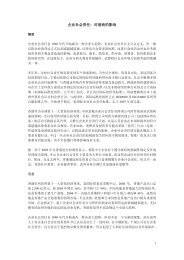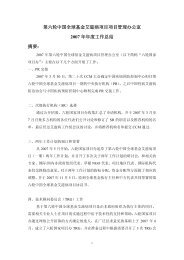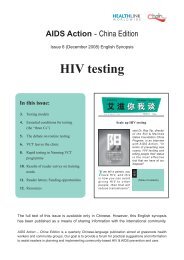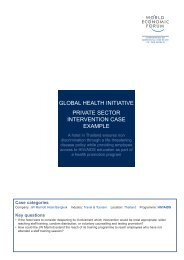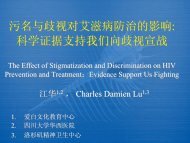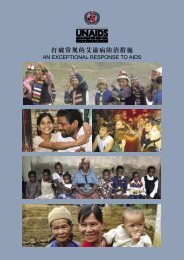F igure 2Comparison of Average Number of Clients PerCommercial Sex Worker (CSW) Versus Percentageof Young Men Who Utilized Sex WorkersAverage # of CSW clients/day43.532.521.510.50■ Indonesia■ Philipp<strong>in</strong>es■ Cambodia■ Thail<strong>and</strong>0 10 20 30 40 50 60% of males us<strong>in</strong>g sex workersmodes of transmission. These have yet to be adequatelydel<strong>in</strong>eated <strong>and</strong> entered <strong>in</strong>to the complex equation ofepidemic dynamics.T HE EPIDEMICS OFSUB-SAHARAN AFRICAThe global p<strong>and</strong>emic consists of a mosaic of <strong>in</strong>dividualepidemics <strong>in</strong> countries around the world. Theoldest set of epidemics can be found <strong>in</strong> sub-SaharanAfrica. Of the 36 million people liv<strong>in</strong>g with<strong>HIV</strong>/<strong>AIDS</strong> globally, more than 25 million (70 percent)are <strong>in</strong> sub-Saharan Africa. This region <strong>in</strong>cludesonly 11 percent of the world’s population. Nearly one<strong>in</strong> 10 adults between the ages of 15 <strong>and</strong> 49 is alreadyliv<strong>in</strong>g with the virus throughout the sub-cont<strong>in</strong>ent.In Africa women are harder hit than men, theopposite of what is found on all other cont<strong>in</strong>ents. Thedifference between men <strong>and</strong> women is most pronounced<strong>in</strong> those under age 25. A population-basedsurvey <strong>in</strong> Kisumu, Kenya, showed <strong>HIV</strong> rates <strong>in</strong> 15-<strong>and</strong> 16-year-old girls of 8 percent <strong>and</strong> 18 percent,while no <strong>in</strong>fections were documented <strong>in</strong> boys of thesame age. In 19-year-old girls the rates were up to 33percent, <strong>and</strong> only 9 percent <strong>in</strong>boys. We do not fully underst<strong>and</strong>the reasons for these extremelyhigh rates <strong>in</strong> girls. Young girls’biological vulnerability <strong>and</strong> the factthat girls frequently have sex partnersof much higher age—withhigh levels of <strong>in</strong>fection—likely playa role.There are at least three patternsof transmission <strong>in</strong> sub-SaharanAfrica:In the countries of EastAfrica, the oldest <strong>HIV</strong> epidemics<strong>in</strong> the world have had slow, steadyprogress over the past 30 years.These are seen <strong>in</strong> the Great Lakesregions of East Africa—<strong>in</strong> thecountries of Ug<strong>and</strong>a, Tanzania,Malawi, Kenya, Zambia <strong>and</strong> the Democratic Republicof the Congo (formerly Zaire).In the countries of West Africa, where theepidemic seems to have started about 10 years later,progression of the epidemic has been more <strong>in</strong>dolent<strong>and</strong> is further complicated by the presence of both<strong>HIV</strong>-1 <strong>and</strong> <strong>HIV</strong>-2. The national prevalence ratesare generally lower, between one percent <strong>and</strong> eightpercent, except for Côte d’Ivoire.In Southern Africa, where the epidemic started<strong>in</strong> the mid-to late 1980s, there has been a series ofexplosive epidemics over the past eight years, reach<strong>in</strong>gthe highest prevalence levels on earth, 20 percent to40 percent. These countries <strong>in</strong>clude South Africa,Namibia, Zimbabwe, Botswana, Swazil<strong>and</strong> <strong>and</strong>Lesotho.Among the features of the epidemics <strong>in</strong> this region:■■Half of new <strong>in</strong>fections <strong>in</strong> Africa are among 16- to23-year-olds, three-quarters of them young girls<strong>and</strong> women. More than 80 percent of <strong>HIV</strong> transmissionis heterosexual, with more than 55 percentof <strong>in</strong>fections <strong>in</strong> sub-Saharan Africa occurr<strong>in</strong>g <strong>in</strong>women due to <strong>in</strong>creased physiological <strong>and</strong> socioeconomicvulnerability.Several studies <strong>in</strong> sub-Saharan Africa have notedthat <strong>HIV</strong> prevalence is high <strong>in</strong> young womenwith<strong>in</strong> the first few years of sexual activity, but rises<strong>HIV</strong>/<strong>AIDS</strong> <strong>Prevention</strong> <strong>and</strong> <strong>Care</strong> <strong>in</strong> <strong>Resource</strong>-Constra<strong>in</strong>ed Sett<strong>in</strong>gs IX
F igure 3<strong>HIV</strong> Seroprevalence for Pregnant Women<strong>in</strong> Selected Urban Areas of Africa: 1985–199950<strong>HIV</strong> Seroprevalence (%)45Francistown4035BlantyreKwazulu/Natal3025201510LusakaKampalaHarareNairobiAbidjanLagos50DakarYaounde1985 1987 1989 1991 1993 1995 1997 1999Note: Includes <strong>in</strong>fection from <strong>HIV</strong>-1 <strong>and</strong>/or <strong>HIV</strong>-2.Source: U.S. Census Bureau, <strong>HIV</strong>/<strong>AIDS</strong> Surveillance Data Base, 2000.■more slowly <strong>in</strong> young men. Recent data from foururban populations <strong>and</strong> one rural population confirmdramatic male-female differences (see Figure4). In this vicious cycle young girls are <strong>in</strong>fected byolder men; the girls as they age then <strong>in</strong>fect theirsame-age partners <strong>and</strong> husb<strong>and</strong>s; <strong>and</strong> these men asthey age <strong>in</strong> turn <strong>in</strong>fect young girls.The <strong>in</strong>creas<strong>in</strong>g number of <strong>HIV</strong>-<strong>in</strong>fected womenhas led to the <strong>in</strong>fection of nearly 600,000 <strong>in</strong>fantseach year. Although new, more realistic <strong>in</strong>terventionsto reduce mother-to-child transmission(MTCT) of the virus are be<strong>in</strong>g developed, fewerthan five percent of women <strong>in</strong> sub-Saharan Africahave access to these treatment regimens.T HE EPIDEMICS OF ASIAWith a population of nearly 3.5 billion—represent<strong>in</strong>gnearly 60 percent of the world’s population—theAsia-Pacific region has the potential to greatly <strong>in</strong>fluencethe course <strong>and</strong> overall impact of the global <strong>HIV</strong>-<strong>AIDS</strong>p<strong>and</strong>emic. 1 <strong>HIV</strong> began to spread <strong>in</strong> this region <strong>in</strong> theearly to mid-1980s, reflect<strong>in</strong>g risk behavior <strong>in</strong> two discreteareas: commercial sex work (CSW) <strong>and</strong> <strong>in</strong>jectiondrug use (IDU). Dur<strong>in</strong>g the 1980s <strong>and</strong> early 1990s,there was extensive spread among men who have sexwith men (MSM) <strong>in</strong> several Asian Pacific countries,<strong>in</strong>clud<strong>in</strong>g Australia, New Zeal<strong>and</strong>, Japan, Malaysia,X <strong>HIV</strong>/<strong>AIDS</strong> <strong>Prevention</strong> <strong>and</strong> <strong>Care</strong> <strong>in</strong> <strong>Resource</strong>-Constra<strong>in</strong>ed Sett<strong>in</strong>gs




